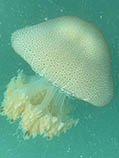Rhopilema hispidum (Vanhöffen, 1888)
Sand jellyfish
Classification / Names Common names | Synonyms | CoL | ITIS | WoRMS
Scyphozoa | Rhizostomeae | Rhizostomatidae
Environment: milieu / climate zone / depth range / distribution range Ecology
Pelagic-neritic. Tropical; 45°N - 20°S, 44°E - 146°E (Ref. 121705)
Distribution Countries | FAO areas | Ecosystems | Occurrences | Introductions
Indo-West Pacific: from Gulf of Aden north to Japan and east to Pacific..
Length at first maturity / Size / Weight / Age
Maturity: Lm ? range ? - ? cm Max length : 70.0 cm WD male/unsexed; (Ref. 121705)
Short description Morphology
25 to 34 cm wide, exumbrella with numerous small, sharp-pointed, conical projections; in each octant about eight valer lappets, oblong, rounded; moutharms terminante in a lrge clubshaped appendage with a faceted, swollen end, other club-shaped appendages between the mouths on the three wings.
Depth estimate based on habitat data from its ecology. Found in coastal waters (Refs. 63414, 122791), in a bay (Ref. 122790) and estuary (Ref. 122791). Commensals: host to a few fishes (carangid, eel larvae, ponyfish), a shrimp, a crab, a copepod, and a flatworm (Ref. 116535). Also associated with the ophiuroid Ophiocnemis marmorata Ref. 122791).
Life cycle and mating behavior Maturity | Reproduction | Spawning | Eggs | Fecundity | Larvae
Members of the class Scyphozoa are gonochoric. Life cycle: Egg is laid by the adult medusa which later develops into a free-living planula, then to a scyphistoma to a strobila, and lastly to a free-living young medusa.
Main reference
References | Coordinator | Collaborators
Kramp, P.L. 1961. (Ref. 2992)
IUCN Red List Status (Ref. 130435)
CITES status (Ref. 108899)
Not Evaluated
CMS (Ref. 116361)
Not Evaluated
Threat to humans
Human uses
Fisheries: commercial
| FishSource |
Tools
More information
Internet sources
BHL | BOLD Systems | CISTI | DiscoverLife | FAO(Publication : search) | Fishipedia | GenBank (genome, nucleotide) | GloBI | Gomexsi | Google Books | Google Scholar | Google | PubMed | Tree of Life | Wikipedia (Go, Search) | Zoological Record



